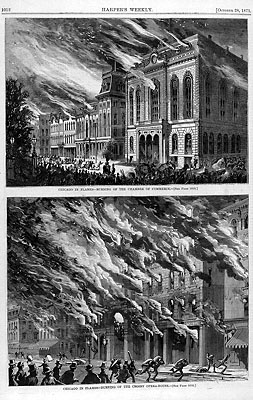
The Great Conflagration
{Main}
Besides the fact that the Great Chicago Fire started around 9 o'clock on Sunday evening, October 8, 1871, somewhere in or very near the O'Leary barn, How it started is yet unknown. But, given the dry summer and the careless way the city had been built and managed, a kick from a cow would have been sufficient but by no means necessary to burn Chicago down. As A.T. Andreas, the city's leading historian, put it, "Nature had withheld her accustomed measure of prevention, and man had added to the peril by recklessness."Chicago averaged about two fires a day the previous year, including twenty in the preceding week. The largest of these occurred just on Saturday night. Firemen still might have been able to contain the Sunday blaze but for a series of technological and human failures in the alarm system. The fire, driven by a strong wind out of the southwest, headed straight for the center of the city. It divided unpredictably into separate parts by hurling out flaming brands on the superheated draft it generated, leaping the South Branch of the Chicago River around midnight. Dividing yet again, it made short work of Conley's Patch. By 1:30 it reached the Courthouse tower, from which the watchman barely escaped through the burning stairway by sliding down the banisters. When city officials realized that the building was itself doomed, they released the prisoners from the basement just before the great bell plummeted through the collapsing tower.
